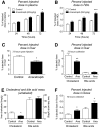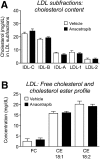Anacetrapib promotes reverse cholesterol transport and bulk cholesterol excretion in Syrian golden hamsters
- PMID: 21841206
- PMCID: PMC3196228
- DOI: 10.1194/jlr.M016410
Anacetrapib promotes reverse cholesterol transport and bulk cholesterol excretion in Syrian golden hamsters
Abstract
Cholesteryl ester transfer protein (CETP) transfers cholesteryl ester (CE) and triglyceride between HDL and apoB-containing lipoproteins. Anacetrapib (ANA), a reversible inhibitor of CETP, raises HDL cholesterol (HDL-C) and lowers LDL cholesterol in dyslipidemic patients; however, the effects of ANA on cholesterol/lipoprotein metabolism in a dyslipidemic hamster model have not been demonstrated. To test whether ANA (60 mg/kg/day, 2 weeks) promoted reverse cholesterol transport (RCT), ³H-cholesterol-loaded macrophages were injected and (3)H-tracer levels were measured in HDL, liver, and feces. Compared to controls, ANA inhibited CETP (94%) and increased HDL-C (47%). ³H-tracer in HDL increased by 69% in hamsters treated with ANA, suggesting increased cholesterol efflux from macrophages to HDL. ³H-tracer in fecal cholesterol and bile acids increased by 90% and 57%, respectively, indicating increased macrophage-to-feces RCT. Mass spectrometry analysis of HDL from ANA-treated hamsters revealed an increase in free unlabeled cholesterol and CE. Furthermore, bulk cholesterol and cholic acid were increased in feces from ANA-treated hamsters. Using two independent approaches to assess cholesterol metabolism, the current study demonstrates that CETP inhibition with ANA promotes macrophage-to-feces RCT and results in increased fecal cholesterol/bile acid excretion, further supporting its development as a novel lipid therapy for the treatment of dyslipidemia and atherosclerotic vascular disease.
Figures








Similar articles
-
Anacetrapib and dalcetrapib differentially alters HDL metabolism and macrophage-to-feces reverse cholesterol transport at similar levels of CETP inhibition in hamsters.Eur J Pharmacol. 2014 Oct 5;740:135-43. doi: 10.1016/j.ejphar.2014.06.022. Epub 2014 Jul 5. Eur J Pharmacol. 2014. PMID: 25008069
-
In vivo effects of anacetrapib on preβ HDL: improvement in HDL remodeling without effects on cholesterol absorption.J Lipid Res. 2013 Oct;54(10):2858-65. doi: 10.1194/jlr.M041541. Epub 2013 Jul 29. J Lipid Res. 2013. PMID: 23898048 Free PMC article.
-
Liver X receptor activation promotes macrophage-to-feces reverse cholesterol transport in a dyslipidemic hamster model.J Lipid Res. 2010 Apr;51(4):763-70. doi: 10.1194/jlr.M001552. Epub 2009 Oct 27. J Lipid Res. 2010. PMID: 19965597 Free PMC article.
-
The use of dyslipidemic hamsters to evaluate drug-induced alterations in reverse cholesterol transport.Curr Opin Investig Drugs. 2010 Mar;11(3):289-97. Curr Opin Investig Drugs. 2010. PMID: 20178042 Review.
-
Different effects of compounds decreasing cholesteryl ester transfer protein activity on lipoprotein metabolism.Curr Opin Lipidol. 2011 Aug;22(4):288-95. doi: 10.1097/MOL.0b013e3283475e00. Curr Opin Lipidol. 2011. PMID: 21587074 Review.
Cited by
-
Targeting high density lipoproteins in the prevention of cardiovascular disease?Curr Cardiol Rep. 2012 Dec;14(6):684-91. doi: 10.1007/s11886-012-0317-3. Curr Cardiol Rep. 2012. PMID: 22991041 Free PMC article. Review.
-
Idol Depletion Protects against Spontaneous Atherosclerosis in a Hamster Model of Familial Hypercholesterolemia.Oxid Med Cell Longev. 2022 May 24;2022:1889632. doi: 10.1155/2022/1889632. eCollection 2022. Oxid Med Cell Longev. 2022. PMID: 35656026 Free PMC article.
-
Anacetrapib as a potential cardioprotective strategy.Drug Des Devel Ther. 2017 Dec 7;11:3497-3502. doi: 10.2147/DDDT.S114104. eCollection 2017. Drug Des Devel Ther. 2017. PMID: 29263647 Free PMC article. Review.
-
Omega 3 fatty acids promote macrophage reverse cholesterol transport in hamster fed high fat diet.PLoS One. 2013 Apr 22;8(4):e61109. doi: 10.1371/journal.pone.0061109. Print 2013. PLoS One. 2013. PMID: 23613796 Free PMC article.
-
Simultaneous Determination of Biliary and Intestinal Cholesterol Secretion Reveals That CETP (Cholesteryl Ester Transfer Protein) Alters Elimination Route in Mice.Arterioscler Thromb Vasc Biol. 2019 Oct;39(10):1986-1995. doi: 10.1161/ATVBAHA.119.312952. Epub 2019 Aug 29. Arterioscler Thromb Vasc Biol. 2019. PMID: 31462090 Free PMC article.
References
-
- Gordon T., Castelli W. P., Hjortland M. C., Kannel W. B., Dawber T. R. 1977. High-density lipoprotein as a protective factor against coronary heart-disease - Framingham Study. Am. J. Med. 62: 707–714 - PubMed
-
- Miller N. E., Thelle D. S., Forde O. H., Mjos O. D. 1977. Tromso Heart-Study - high-density lipoprotein and coronary heart-disease - prospective case-control study. Lancet. 1: 965–968 - PubMed
-
- Keys A. 1980. Alpha-lipoprotein (Hdl) cholesterol in the serum and the risk of coronary heart-disease and death. Lancet. 2: 603–606 - PubMed
-
- Jacobs D. R., Mebane I. L., Bangdiwala S. I., Criqui M. H., Tyroler H. A. 1990. High-density lipoprotein cholesterol as a predictor of cardiovascular-disease mortality in men and women - the follow-up-study of the Lipid Research Clinics Prevalence Study. Am. J. Epidemiol. 131: 32–47 - PubMed
MeSH terms
Substances
LinkOut - more resources
Full Text Sources
Other Literature Sources
Medical
Miscellaneous

